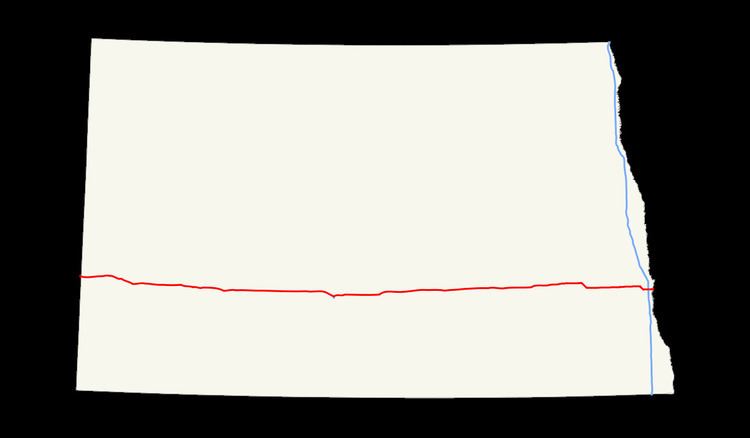Length 567.1 km | ||
 | ||
Interstate 94 runs east–west through the central portion of the U.S. state of North Dakota.
Contents
Route description
The route enters from Montana at Beach and immediately heads east, passing Dickinson, Bismarck, and Jamestown before entering Fargo and finally exiting the state.
The route passes to the south of Theodore Roosevelt National Park's southern unit. Access to the Northern unit is possible by taking US 85 north from Belfield.
The route crosses from Mountain Time Zone (UTC−7) into Central Time Zone (UTC−6) at the Stark/Morton County line and vice versa.
The route has a 75 miles per hour (121 km/h) posted speed limit between the Montana state line and Mandan near mile marker 152; a 60 miles per hour (97 km/h) posted speed limit between Mandan near mile marker 152 and Bismarck mile marker 160; a 75 miles per hour (121 km/h) posted speed limit between Bismarck at mile marker 160 and West Fargo near exit 346; a 65 miles per hour (105 km/h) posted speed limit in West Fargo between exit 346 and mile marker 347; and a 55 miles per hour (89 km/h) posted speed limit between West Fargo at mile marker 347 to the Minnesota state line.
Interstate 94 has two lanes in each direction through most of the state and 3 lanes in each direction in the Bismarck/Mandan area, from Exit 155 to Exit 156, and from the 45th Street exit (Exit 348) to the Red River (Minnesota state line) in Fargo.
Points of interest
The route enters at Beach and passes through the Badlands near Medora (near the Theodore Roosevelt National Park (South Unit)). A public rest area about seven miles (11 km) east of Medora provides an awe-inspiring view, especially at sunset, and an opportunity to hike through some of the scenery on the Painted Canyon Trail. Further east, I-94 provides access to the North Unit of Theodore Roosevelt National Park, then passes through the cities of Dickinson, Mandan, Bismarck, Jamestown, and Valley City on the way to West Fargo and Fargo, where it leaves the state and crosses into Minnesota. Throughout the state, the route generally travels relatively straight east and west following both the railroad route and the former route of US 10 (called "The Old Red Trail" or less commonly "The National Parks Trail"), where its western terminus is at Exit 343 in West Fargo.
The highway intersects with the Enchanted Highway 11 miles east of Dickinson at Exit 72. (The small green mile signs on the side of the road initialize at zero on the Montana border). At New Salem, it passes Salem Sue, a 38 foot high sculpture of a Holstein cow and is clearly visible from I-94 on the south side of the road. A drive up the road to Sue will take you to a vantage point where you can see a panoramic landscape for many miles. Between Mandan and Bismarck, I-94 crosses the Missouri River with a view of the Northern Pacific/BNSF Railroad Bridge on the South side of the road. At Steele, it passes the world's largest sculpture of a sand hill crane (named Sandy), which is 40 feet tall and visible from I-94 on the south side of the road, just to the east of exit 200. At Jamestown, it passes the world's largest sculpture of a buffalo (actually bison) named "Dakota Thunder", which is 28 feet tall and is visible from I-94 on the north side of the road.
At approximately mile marker 275 on the westbound lanes between Jamestown and Valley City, the highway crosses the Laurentian Continental Divide. The rivers that are west of this divide flow South into the Atlantic Ocean at the Gulf of Mexico, while the rivers that are east of the divide flow North into the Arctic Ocean. The James River, that flows through Jamestown, feeds into the Atlantic Ocean, while the Sheyenne River, that flows through Valley City (36 miles east of Jamestown), feeds into the Arctic Ocean.
In Fargo, a well-known, but unnamed pedestrian bridge crosses over I-94. The bridge was built in 1976, in time for the United States' bicentennial. While providing a unique crossing for the surrounding neighborhoods, the bridge serves as a landmark for commuters and travelers. Westbound, it is one of the first North Dakota landmarks visible from the highway.
History
Through the state, Interstate 94 follows the route once taken by U.S. Highway 10 west from Fargo. This route was originally called "The Old Red Trail". Prairie Public Television in North Dakota produced a documentary about US Highway 10 and the building of I-94 through the state.
Interstate 94 roughly follows the route of the former Northern Pacific Railway mainline (now a BNSF Railway route) across North Dakota. Many of the towns and cities that I-94 serves first grew as railroad towns in the nineteenth and early twentieth centuries.
The first section of I-94 completed with Interstate funds (under the Federal-Aid Highway Act of 1956) was a 12-mile (19 km) section between Jamestown and Valley City, North Dakota in 1958.
